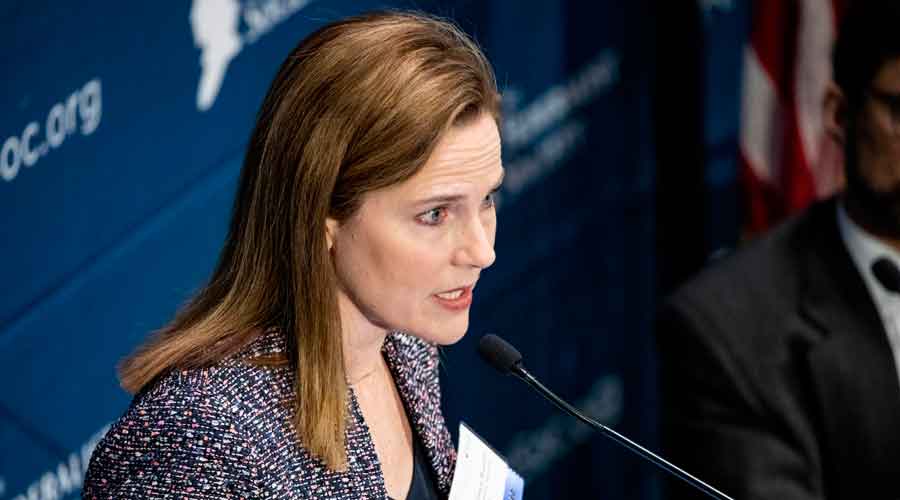President Donald Trump has selected Judge Amy Coney Barrett, the favourite candidate of conservatives, to succeed Justice Ruth Bader Ginsburg and will try to force Senate confirmation before Election Day in a move that would significantly alter the ideological makeup of the Supreme Court for years.
Trump plans to announce on Saturday that she is his choice, according to six people close to the process who asked not to be identified. As they often do, aides cautioned that Trump sometimes upends his own plans.
But he is not known to have interviewed any other candidates and came away from two days of meetings with Judge Barrett this week impressed with a jurist he was told would be a female Antonin Scalia, referring to the justice she once clerked for. On Friday night, Judge Barrett was photographed getting out of her car outside her home in South Bend, Indiana.
“I haven’t said it was her, but she is outstanding,” Trump told reporters who asked about Judge Barrett’s imminent nomination at Joint Base Andrews outside Washington after CNN and other news outlets reported on his choice.
The President’s political advisers hope the selection will energise his conservative political base in the thick of an election campaign in which he has for months been trailing former Vice-President Joseph R. Biden Jr., his Democratic challenger. But it could also rouse liberal voters afraid that her confirmation could spell the end of Roe v. Wade, the decision legalising abortion, as well as other rulings popular with the political left and centre.
The nomination will kick off an extraordinary scramble by Senate Republicans to confirm her for the court in the 38 days before the election on November 3, a scenario unlike any in American history.
In picking Judge Barrett, a conservative and a hero to the anti-abortion movement, Trump could hardly have found a more polar opposite to Justice Ginsburg, a pioneering champion of women’s rights and leader of the liberal wing of the court. The appointment would shift the centre of gravity on the bench considerably to the right, giving conservatives six of the nine seats and potentially insulating them even against defections by Chief Justice John G. Roberts Jr., who on a handful of occasions has sided with liberal justices.
Trump made clear this week that he wanted to rush his nominee through the Senate by Election Day to ensure that he would have a decisive fifth justice on his side in case any disputes from the vote reached the high court, as he expected to happen. The President has repeatedly made baseless claims that the Democrats are trying to steal the election and appears poised to challenge any result of the balloting that does not declare him the winner.
Senator Mitch McConnell, Republican of Kentucky and the majority leader, has enough votes to push through Judge Barrett’s nomination if he can make the tight time frame work. Republicans are looking at holding hearings before the Senate judiciary committee the week of October 16 and a floor vote by late October.
Democrats have expressed outrage at the rush but they have few options for slowing the nomination, much less stopping it. Instead, they have focused on making Republicans pay at the ballot box and debated ways to counteract Trump’s influence on the court if they win the election.
Trump met Judge Barrett at the White House on Monday and Tuesday and was said to like her personally. While he said he had a list of five finalists, he never interviewed anyone else for the job and passed over Judge Barbara Lagoa of the US Court of Appeals for the 11th Circuit, who appealed to campaign advisers in particular because of her Cuban-American heritage and roots in Florida, a critical battleground state in the presidential contest.
The President has long signalled that he expected to put Judge Barrett on the court and has been quoted telling confidants in 2018 that he was “saving her for Ginsburg”.
If confirmed, Judge Barrett would become the 115th justice in the nation’s history and the fifth woman ever to serve on the Supreme Court. At 48, she would be the youngest member of the current court as well its sixth Catholic. And she would become Trump’s third appointee on the court, more than any other President has installed in a first term since Richard M. Nixon had four.
Judge Barrett graduated from Notre Dame Law School and later joined the faculty. She clerked for Justice Scalia and shares his constitutional views. She is described as a textualist who interprets the law based on its plain words rather than seeking to understand the legislative purpose and an originalist who applies the Constitution as it was understood by those who drafted and ratified it.
She has been a judge for only three years, appointed by Trump to the US Court of Appeals for the Seventh Circuit in 2017.
New York Times News Service










